[English] 日本語
 Yorodumi
Yorodumi- PDB-2z4e: Crystal Structure of D-Dimer from Human Fibrin Complexed with Gly... -
+ Open data
Open data
- Basic information
Basic information
| Entry | Database: PDB / ID: 2z4e | |||||||||
|---|---|---|---|---|---|---|---|---|---|---|
| Title | Crystal Structure of D-Dimer from Human Fibrin Complexed with Gly-His-Arg-Pro-Tyr-amide | |||||||||
 Components Components |
| |||||||||
 Keywords Keywords | BLOOD CLOTTING / fibrin clots / B-knobs / beta-holes | |||||||||
| Function / homology |  Function and homology information Function and homology informationblood coagulation, common pathway / induction of bacterial agglutination / fibrinogen complex / Regulation of TLR by endogenous ligand / platelet alpha granule / blood coagulation, fibrin clot formation / cellular response to leptin stimulus / positive regulation of heterotypic cell-cell adhesion / MyD88 deficiency (TLR2/4) / IRAK4 deficiency (TLR2/4) ...blood coagulation, common pathway / induction of bacterial agglutination / fibrinogen complex / Regulation of TLR by endogenous ligand / platelet alpha granule / blood coagulation, fibrin clot formation / cellular response to leptin stimulus / positive regulation of heterotypic cell-cell adhesion / MyD88 deficiency (TLR2/4) / IRAK4 deficiency (TLR2/4) / extracellular matrix structural constituent / MyD88:MAL(TIRAP) cascade initiated on plasma membrane / plasminogen activation / p130Cas linkage to MAPK signaling for integrins / positive regulation of peptide hormone secretion / positive regulation of vasoconstriction / GRB2:SOS provides linkage to MAPK signaling for Integrins / positive regulation of exocytosis / protein secretion / cellular response to interleukin-1 / protein polymerization / Integrin cell surface interactions / Common Pathway of Fibrin Clot Formation / negative regulation of endothelial cell apoptotic process / negative regulation of extrinsic apoptotic signaling pathway via death domain receptors / cell adhesion molecule binding / fibrinolysis / Integrin signaling / positive regulation of substrate adhesion-dependent cell spreading / platelet alpha granule lumen / cell-matrix adhesion / positive regulation of protein secretion / Post-translational protein phosphorylation / Signaling by high-kinase activity BRAF mutants / MAP2K and MAPK activation / response to calcium ion / platelet aggregation / Regulation of Insulin-like Growth Factor (IGF) transport and uptake by Insulin-like Growth Factor Binding Proteins (IGFBPs) / Signaling by RAF1 mutants / Signaling by moderate kinase activity BRAF mutants / Paradoxical activation of RAF signaling by kinase inactive BRAF / Signaling downstream of RAS mutants / Signaling by BRAF and RAF1 fusions / Platelet degranulation / extracellular vesicle / ER-Phagosome pathway / protein-folding chaperone binding / : / protein-containing complex assembly / blood microparticle / cell cortex / protein-macromolecule adaptor activity / adaptive immune response / positive regulation of ERK1 and ERK2 cascade / Amyloid fiber formation / endoplasmic reticulum lumen / signaling receptor binding / innate immune response / external side of plasma membrane / synapse / structural molecule activity / cell surface / endoplasmic reticulum / extracellular space / extracellular exosome / extracellular region / metal ion binding / plasma membrane Similarity search - Function | |||||||||
| Biological species |  Homo sapiens (human) Homo sapiens (human) | |||||||||
| Method |  X-RAY DIFFRACTION / X-RAY DIFFRACTION /  SYNCHROTRON / SYNCHROTRON /  MOLECULAR REPLACEMENT / Resolution: 2.7 Å MOLECULAR REPLACEMENT / Resolution: 2.7 Å | |||||||||
 Authors Authors | Doolittle, R.F. / Pandi, L. | |||||||||
 Citation Citation |  Journal: Biochemistry / Year: 2007 Journal: Biochemistry / Year: 2007Title: Probing the beta-chain hole of fibrinogen with synthetic peptides that differ at their amino termini Authors: Doolittle, R.F. / Pandi, L. | |||||||||
| History |
| |||||||||
| Remark 300 | BIOMOLECULE: 1 The set of chains A-B-C is covalently cross-linked to the set D-E-F. But the cross- ...BIOMOLECULE: 1 The set of chains A-B-C is covalently cross-linked to the set D-E-F. But the cross-links (between a particular glutamine and a particular lysine in the C and F chains) occur in a part of the structure that doesn't appear in the electron density. |
- Structure visualization
Structure visualization
| Structure viewer | Molecule:  Molmil Molmil Jmol/JSmol Jmol/JSmol |
|---|
- Downloads & links
Downloads & links
- Download
Download
| PDBx/mmCIF format |  2z4e.cif.gz 2z4e.cif.gz | 253.1 KB | Display |  PDBx/mmCIF format PDBx/mmCIF format |
|---|---|---|---|---|
| PDB format |  pdb2z4e.ent.gz pdb2z4e.ent.gz | 204.2 KB | Display |  PDB format PDB format |
| PDBx/mmJSON format |  2z4e.json.gz 2z4e.json.gz | Tree view |  PDBx/mmJSON format PDBx/mmJSON format | |
| Others |  Other downloads Other downloads |
-Validation report
| Summary document |  2z4e_validation.pdf.gz 2z4e_validation.pdf.gz | 846.5 KB | Display |  wwPDB validaton report wwPDB validaton report |
|---|---|---|---|---|
| Full document |  2z4e_full_validation.pdf.gz 2z4e_full_validation.pdf.gz | 891 KB | Display | |
| Data in XML |  2z4e_validation.xml.gz 2z4e_validation.xml.gz | 50.9 KB | Display | |
| Data in CIF |  2z4e_validation.cif.gz 2z4e_validation.cif.gz | 68.5 KB | Display | |
| Arichive directory |  https://data.pdbj.org/pub/pdb/validation_reports/z4/2z4e https://data.pdbj.org/pub/pdb/validation_reports/z4/2z4e ftp://data.pdbj.org/pub/pdb/validation_reports/z4/2z4e ftp://data.pdbj.org/pub/pdb/validation_reports/z4/2z4e | HTTPS FTP |
-Related structure data
| Related structure data | 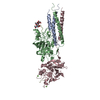 2q9iC  1fzfS S: Starting model for refinement C: citing same article ( |
|---|---|
| Similar structure data |
- Links
Links
- Assembly
Assembly
| Deposited unit | 
| ||||||||
|---|---|---|---|---|---|---|---|---|---|
| 1 | 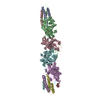
| ||||||||
| 2 | 
| ||||||||
| 3 | 
| ||||||||
| Unit cell |
|
- Components
Components
-Protein , 3 types, 6 molecules ADBECF
| #1: Protein | Mass: 10244.963 Da / Num. of mol.: 2 / Fragment: residues in database 130-218 / Source method: isolated from a natural source / Source: (natural)  Homo sapiens (human) / References: UniProt: P02671 Homo sapiens (human) / References: UniProt: P02671#2: Protein | Mass: 37435.730 Da / Num. of mol.: 2 / Fragment: residues in database 164-491 / Source method: isolated from a natural source / Source: (natural)  Homo sapiens (human) / References: UniProt: P02675 Homo sapiens (human) / References: UniProt: P02675#3: Protein | Mass: 36693.754 Da / Num. of mol.: 2 / Fragment: residues in database 114-437 / Source method: isolated from a natural source / Source: (natural)  Homo sapiens (human) / References: UniProt: Q53Y18, UniProt: P02679*PLUS Homo sapiens (human) / References: UniProt: Q53Y18, UniProt: P02679*PLUS |
|---|
-Fibrin B knob ... , 2 types, 4 molecules STIJ
| #4: Protein/peptide | Mass: 467.522 Da / Num. of mol.: 2 / Source method: obtained synthetically / Details: The sequence occurs naturally in humans. #5: Protein/peptide | Mass: 630.696 Da / Num. of mol.: 2 / Source method: obtained synthetically Details: The sequence occurs naturally in bovines (e.g., Bos taurus). References: UniProt: P02676*PLUS |
|---|
-Sugars , 2 types, 3 molecules 
| #6: Polysaccharide | 2-acetamido-2-deoxy-beta-D-glucopyranose-(1-4)-2-acetamido-2-deoxy-beta-D-glucopyranose Source method: isolated from a genetically manipulated source |
|---|---|
| #8: Sugar |
-Non-polymers , 1 types, 8 molecules 
| #7: Chemical | ChemComp-CA / |
|---|
-Details
| Has protein modification | Y |
|---|
-Experimental details
-Experiment
| Experiment | Method:  X-RAY DIFFRACTION / Number of used crystals: 1 X-RAY DIFFRACTION / Number of used crystals: 1 |
|---|
- Sample preparation
Sample preparation
| Crystal | Density Matthews: 2.76 Å3/Da / Density % sol: 55.49 % |
|---|---|
| Crystal grow | Temperature: 295 K / Method: vapor diffusion, sitting drop / pH: 7.5 Details: equal volumes of (a) 9 mg/ml D-dimer, 2mM Gly-His-Arg-Pro-amide, 0.05M Tris, pH 7.0, 5mM CaCl2; (b) 10% PEG, 5mM CaCl2, 0.05M Tris, pH 8.0, 2mM sodium azide; The crystal was subsequently ...Details: equal volumes of (a) 9 mg/ml D-dimer, 2mM Gly-His-Arg-Pro-amide, 0.05M Tris, pH 7.0, 5mM CaCl2; (b) 10% PEG, 5mM CaCl2, 0.05M Tris, pH 8.0, 2mM sodium azide; The crystal was subsequently soaked in 0.5mM Gly-His-Arg-Pro-Tyr-amide in solution of came constitution., pH 7.5, VAPOR DIFFUSION, SITTING DROP, temperature 295.0K |
-Data collection
| Diffraction | Mean temperature: 100 K |
|---|---|
| Diffraction source | Source:  SYNCHROTRON / Site: SYNCHROTRON / Site:  ALS ALS  / Beamline: 5.0.1 / Wavelength: 1 Å / Beamline: 5.0.1 / Wavelength: 1 Å |
| Detector | Type: ADSC QUANTUM 4 / Detector: CCD / Date: Jan 8, 2006 / Details: superbend |
| Radiation | Monochromator: single crystal, cylindrically bent, Si(220) / Protocol: SINGLE WAVELENGTH / Monochromatic (M) / Laue (L): M / Scattering type: x-ray |
| Radiation wavelength | Wavelength: 1 Å / Relative weight: 1 |
| Reflection | Resolution: 2.66→50 Å / Num. all: 56549 / Num. obs: 55743 / % possible obs: 99.9 % / Observed criterion σ(F): 1 / Observed criterion σ(I): 1 / Redundancy: 9.7 % / Rsym value: 0.071 / Net I/σ(I): 14.4 |
| Reflection shell | Resolution: 2.66→2.76 Å / Redundancy: 7.9 % / Rsym value: 0.294 / % possible all: 99.6 |
- Processing
Processing
| Software |
| ||||||||||||||||||||||||||||
|---|---|---|---|---|---|---|---|---|---|---|---|---|---|---|---|---|---|---|---|---|---|---|---|---|---|---|---|---|---|
| Refinement | Method to determine structure:  MOLECULAR REPLACEMENT MOLECULAR REPLACEMENTStarting model: 1FZF Resolution: 2.7→30 Å / Cross valid method: THROUGHOUT / σ(F): 1
| ||||||||||||||||||||||||||||
| Solvent computation | Bsol: 24.122 Å2 | ||||||||||||||||||||||||||||
| Displacement parameters | Biso mean: 40.916 Å2
| ||||||||||||||||||||||||||||
| Refinement step | Cycle: LAST / Resolution: 2.7→30 Å
| ||||||||||||||||||||||||||||
| Refine LS restraints |
| ||||||||||||||||||||||||||||
| Xplor file |
|
 Movie
Movie Controller
Controller




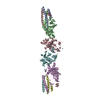
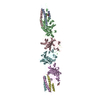




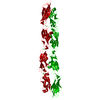

 PDBj
PDBj












